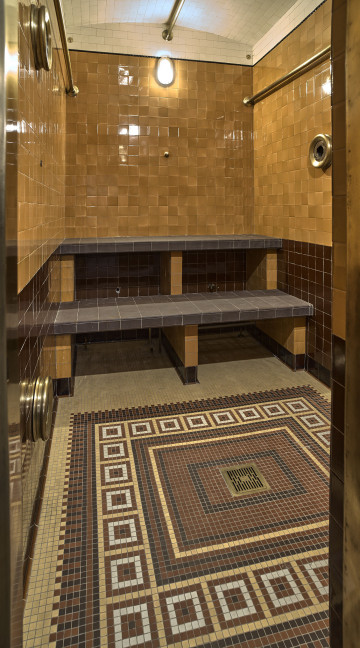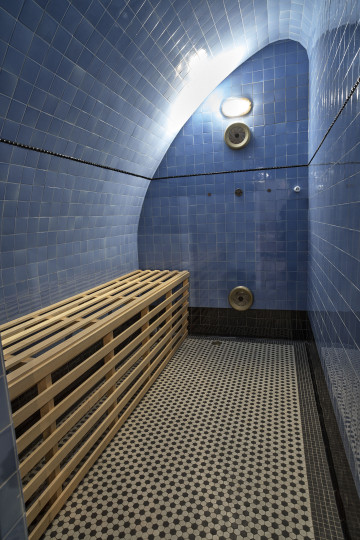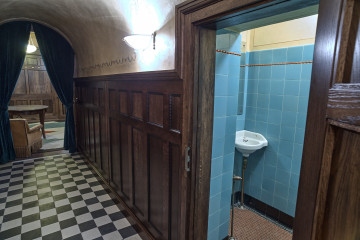
Cellar. Castle Baths. Steam room
1928
Castle Museum in Łańcut
Part of the collection: Interiors
Historical names: The Bathhouse
Other names: The Thermalbath
Time of construction: 1928
Architects: Tadeusz Dachowski(?)
Description:
The most modern undertaking in the Łańcut castle of the last ordinate of Alfred Antoni Potocki in the 20th-century interwar period was the construction of the so-called Roman Baths in 1928 in part of the basement. They were accessed from the northern, single-story corridor. Another way of communication between the baths and all floors was through the elevator. This recreational complex, consisting of vaulted chambers lined with porcelain tiles or wainscot and embellished with painted decorations, was intended for broadly understood physical renewal: exercise, massage, hydro- and electrotherapy. They have a whole system of modern bathtubs and balneological and gymnastic equipment. The baths were decorated exquisitely: they are accessed by wide, sumptuous stairs. The waiting room and the bar with painted decorations on the walls and ceilings, with heavy curtains between the rooms, are discreetly illuminated by wall lamps. There are leather club armchairs and sofas, and the bar has a tall counter and stools. The ordinate invited his guests to the baths - being there became one of the attractions in Łańcut.
The bathhouse has a rectangular (almost square) plan, with a barrel vault entirely lined with ceramic tiles. In the lower part of the bathhouse, there is a pedestal made of black tiles, above which a wide strip (corresponding to the height of the plinth panelling) is lined with large rectangular honey-coloured tiles, above which the walls and the vault are lined with small, square tiles in light blue colour. In contrast, the vault cradle has longitudinal stripes directly over the plinth made of honey-coloured tiles and sapphire tiles; the width and density decrease with height. The floor is made of honey, sapphire and sand tiles in the pattern of squares framed by a border with a meander motif. At the southern wall, there is a bathtub and "Sitzbad" enclosed in large rectangular honey-coloured tiles with a plinth made of black tiles (similar to the walls) with external, free-standing fittings. At the eastern and western walls, there are free-standing metal devices for various showers, in the corners by the western wall, there are two metal, free-standing drinking fountains in the form of a cup with a small, flat bowl on a tall, straight shaft. There are two round vents framed by a metal ring inside with an airflow regulator designed as an aperture in the camera in the eastern wall. A drain grate is in the centre of the floor. All metal elements are in gold.
There are three doors on the western wall - two metal ones and a wooden door with etched glass leading to a rectangular restroom with a ceramic toilet and a wooden seat. The walls are lined with large white tiles, and the floor with small square ones honey-coloured in the middle, bordered with white, black and dominant red. The vent in the wall is the same as in the bath.
Cholewianka-Kruszyńska Aldona, Łańcut. Dzieje rezydencji Potockich, Bosz, 2009, pp. 125-126
Paterak Marta, Łaźnie i elektroterapia w zamku w Łańcucie, Biuletyn GBL, No. 349, 1994, p. 88
Piotrowski Józef, Zamek w Łańcucie: zwięzły opis dziejów i zbiorów, Lviv 1933, p. 45
Silber J.S, /Inwentarz fideikomisowy/, 1932, typescript, MZŁ Archive, R/55, k.96
Aldona Cholewianka-Kruszyńska
Other names
bath
Object type
Interiors
Creation time / dating
Creation / finding place
Owner
Castle Museum in Łańcut
Identification number
Location / status

1928
Castle Museum in Łańcut

1928
Castle Museum in Łańcut

1928
Castle Museum in Łańcut
DISCOVER this TOPIC
Castle Museum in Łańcut
DISCOVER this PATH
Educational path